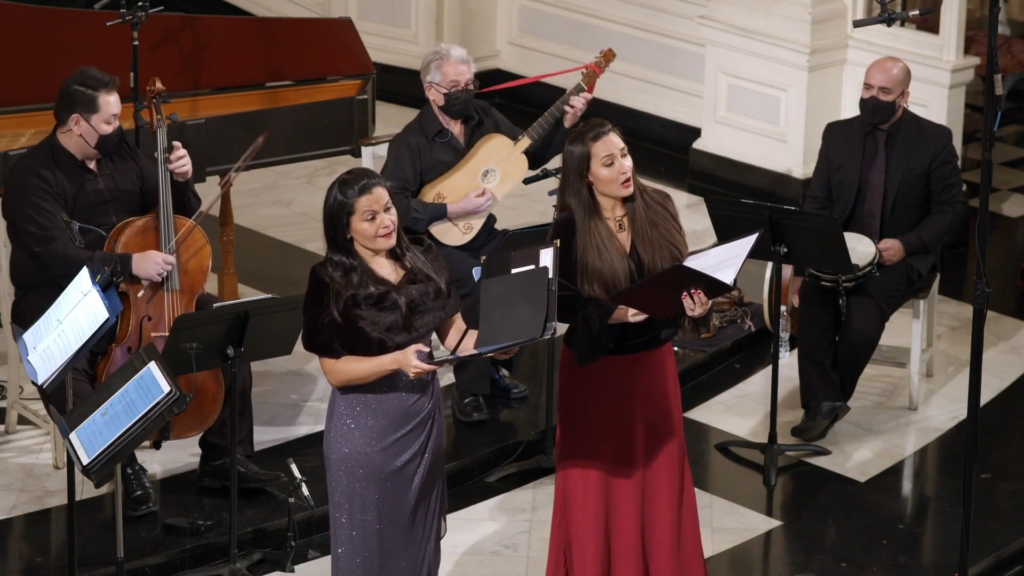The Glories of Spanish Baroque Music Celebrated by Ars Lyrica Houston
While sophisticated musical prowess marked Ars Lyrica Houston’s Friday concert in La Jolla, the ensemble’s exuberant—even playful—approach to performance clearly sets them apart from the typical earnest early music stereotype. No doubt their choice of repertory, primarily Baroque secular music from Spain and the New World, had something to do with their animated good humor.

(l. to r.) Eric Taeyang Mun, Cecilia Duarte, Richard Savino, Camille Ortiz & Jesús Pacheco Mánuel [photo (c.) Tatiana Daubek]
The strengths of Soprano Camille Ortiz and mezzo-soprano Cecilia Duarte, Ars Lyrica’s two vocalists, proved most complementary as they revealed the musical and dramatic depth of this music. Ortiz’s gleaming upper register triumphed over the dull acoustics of St. James -the-Sea Episcopal Church, and the opulence of Duarte’s mezzo-soprano adroitly warmed the room on a chilly January night.
In a similar vein to Araujo’s vivacious “Ay andar a tocar,” the singers animated Mexican composer Antonio de Salazar’s witty villancico “Un ciego que contrabajo” with saucy exchanges driven by percussionist Jesús Pacheco Mánuel’s insistent drumbeats. The song invites listeners to hear an earthy sermon delivered by a blind street singer. The duo opened their program with a purely devotional ballad “A ti Jésus amado” spinning out graceful themes in a comforting triple meter. The Spanish composer, Joseph Pérez, was a contemporary of Antonio Vivaldi and wrote in a similarly ingratiating style. Instrumental accompaniment and cheerful ritornellos were supplied by violinists Stephanie Noori and Maria Lin, cellist Eric Taeyang Mun, guitarist Richard Savino, with artistic director Matthew Dirst on harpsichord or chamber organ.
The instrumental ensemble offered Spanish organist-composer Sebastiám Durón’s “Al dormir el sol,” an elegant contrapuntal fantasia graced with subtle dynamic terracing, as well as the lilting Pastorella from Arcangelo Corelli’s “Christmas” Concerto. Matthew Dirst showed his keyboard prowess with Domenico Scarlatti’s Sonata in C Major. K. 513, a harpsichord solo that begins calmly but increases its bravura demands as it unfolds. Although Italian, Domenico Scarlatti spent most of his career working in royal establishments in Portugal and Spain.
The program by Ars Lyrica Houston was presented by the San Diego Early Music Society at St. James by-the-Sea Episcopal Church in La Jolla on Friday, January 20, 2023.

Ken Herman, a classically trained pianist and organist, has covered music for the San Diego Union, the Los Angeles Times’ San Diego Edition, and for sandiego.com. He has won numerous awards, including first place for Live Performance and Opera Reviews in the 2017, the 2018, and the 2019 Excellence in Journalism Awards competition held by the San Diego Press Club. A Chicago native, he came to San Diego to pursue a graduate degree and stayed.Read more…
